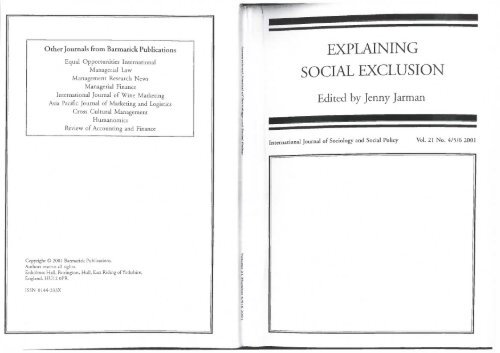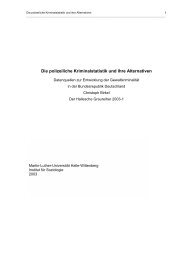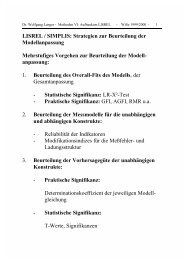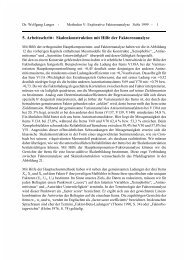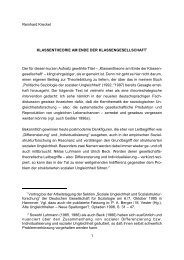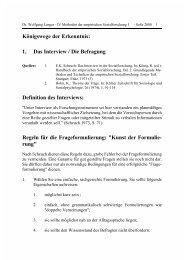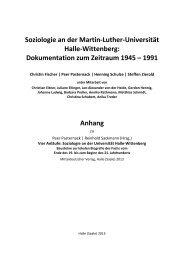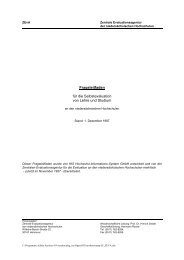EXPLAINING SOCIAL EXCLUSION - Institut für Soziologie
EXPLAINING SOCIAL EXCLUSION - Institut für Soziologie
EXPLAINING SOCIAL EXCLUSION - Institut für Soziologie
Create successful ePaper yourself
Turn your PDF publications into a flip-book with our unique Google optimized e-Paper software.
Other Journals from Barmarick Publications<br />
Equal Opportunities International<br />
Managerial Law<br />
Management Research News<br />
Managerial Finance<br />
International Journal of Wine Marketing<br />
Asia Pacific Journal of Marketing and Logistics<br />
Cross Cultural Management<br />
Humanomics<br />
Review of Accounting and Finance<br />
<strong>EXPLAINING</strong><br />
<strong>SOCIAL</strong> <strong>EXCLUSION</strong><br />
Edited by Jenny Jarman<br />
International Journal of Sociology and Social Policy Vol. 21 No. 4/5/6 2001<br />
Copyright © 2001 Barmarick Publications.<br />
Authors reserve all rights.<br />
Enhoimes Hall, Patrington, Hüll, East Riding of Yorkshire,<br />
England, HUI2 OPR.<br />
ISSN 0144-333X
Editor:<br />
Review Editor:<br />
Associate Editorst<br />
Barric O. Pettman,<br />
International <strong>Institut</strong>e of Social Economics<br />
Jill Manthorpe,<br />
University of Hüll,<br />
Department of Social Work,<br />
Hüll HU6 7RX<br />
Erik Allardt, University of Helsinki<br />
Simon Bekkcr, The Urban Foundation, Johannesburg<br />
Berch Berberoglu, University of Navada<br />
Robert Bierstedt, University of Virginia<br />
Tom Bottomore, University of Sussex<br />
Sally Bould, University of delaware<br />
Benjamin P. Bowser, California Säte University, Hayward<br />
Otar Brox, University of Tromso<br />
Jose Cazaria, University of Granada<br />
Mohamed Cherkaoui, University of Paris - Sorbonne<br />
John Cross.Vassar College<br />
Y. D. Dam'ie, University of Poona<br />
K. Dobbelaere, Catholic University of Leuven<br />
Tim Dowd, Emory University<br />
John Eldridge, University of Glasgow<br />
Maria-Pilar Garcia, Universidad Simon Bolivar<br />
Anthony Giddens, University of Cambridge<br />
Gergory Gizelis, Academy of Athens<br />
Björn Gustaven, Oslo Work Research <strong>Institut</strong>es<br />
Leonard M. Henny, State University of Utrech<br />
H. J. Hoffman-Nowotny, University of Zürich<br />
Hsin-Huang Michael Hsiao, <strong>Institut</strong>e of Ethonology, Taiwan<br />
Ronald N. Jacobs, University at Albany<br />
Mette Jensen, Roskilde Universitetcenter<br />
Ken Judge, University of Kent, Canterbury<br />
David Karen, Bryn Mawr College<br />
Lisa A. Keister, The Ohio State University<br />
Hiroshi Komai, University of Tsukaba<br />
Cheng-shu Kao, Tunghal University, Taiwan<br />
Kilma'n Kulsclr, Hungarian Academy of Sciences<br />
Jolanta Kulspinka, University of Lodz<br />
David Macarov, University of Jerusalem<br />
Donald Mac-Rae, London School of Economics<br />
Zdravko Minar, University of Ljubljana<br />
Alfonso Morales, University of Texas at El Paso<br />
Guiseppe Morosini, Universita delgi stud di Torino<br />
Anna Olszewska, Instyut Filozofii i Socjologii, Warsaw<br />
Eise 0yen, University of Bergen<br />
David N. Pellow, Universiry of Colorado at Boulder<br />
Glanfranco Poggi, Iniversity of Edinburgh<br />
A. G. Schutte, University of Wirwatersrand<br />
Duncan Timms, University of Stirling<br />
Renato Treves, University of Milan<br />
Joji Watanuki, Sophia University<br />
Peter Weingart, University of Bielefeid<br />
Wlodzimierz Wesolowski. Polish Academy<br />
Volume 21 Number 4/5/6 2001<br />
Contents<br />
Explaining Social Exclusion<br />
by Jenny Jarman<br />
Page<br />
Social exclusion and public policy: the relationship between<br />
local school admission arrangements and segregation<br />
by poverty"<br />
by Stephen Gorard, Chris Taylor and John Fitz 10<br />
Young People's Explanations and Experiences of Social<br />
Exclusion: Retrieving Bourdieu's Concept of Social Capital<br />
by Virginia Morrow 37<br />
A Story of "Difference", A Different Story: Young Homeless<br />
Lesbian, Gay and Bisexual People<br />
by Shirley Prendergast, Gillian A. Dünne, David Telford 64<br />
Unemployment and Social Mobility in East German<br />
by Reinhold Sackmann, Michael Windzio and<br />
Matthias Wingens 92<br />
Unemployment without Social Exclusion: Evidence from<br />
Young People In Eastern Europe<br />
by Ken Roberts \<br />
New Fatherhood in Practice? Parental Leave in the UK<br />
by Esther Dermott 145<br />
An International Comparative Analysis of Marriage<br />
Patterns and Social Stratification<br />
by Ken Prandy and Frank L. Jones 165<br />
Inclusion or Exclusion? Reflections on the Evidence of<br />
declining racial disadvantage in the British labour market<br />
by Paul Iganski, GeoffPayne and Judy Roberts \4<br />
Risk of Social Exclusion in Later Life: How well do the<br />
pension Systems of Britain and the US accommodate<br />
women's paid and unpaid work<br />
by Jay Ginn 212<br />
3<br />
j
International Journal of Sociology and Social Policy 92<br />
Unemployment and social mobility in East Germany<br />
by Reinhold Sackmann, Professor, EMPAS, University of Bremen,<br />
Michael Windzio, PD, EMPAS, University of Bremen and Matthias<br />
Wingens, PD, University of Bremen<br />
High unemployment rates are still a major problem faced by many<br />
European societies; the Situation is especially grave during the transition<br />
process from a communist to a market economy. We know that unemployment<br />
has effects on the psychological well-being of persons<br />
affected (Kieselbach 2000) and on the functioning of communities hit<br />
by a high concentration of unemployment (Jahoda, Lazarsfeld and<br />
Zeisel 1971). However, our knowledge with regard to the long-term effects<br />
of unemployment on careers is rather limited. Some authors conclude<br />
that unemployment is only a transition phase in the life course<br />
and has a limited effect on long-term careers (Mutz et al. 1995). In contrast,<br />
other authors argue that unemployment is a first step towards<br />
processes of social exclusion, featuring unemployment äs a major<br />
mechanism of disintegrating certain groups from Society (Kronauer,<br />
Vogel and Gerlach 1993). Major social policy interventions fostering<br />
workfare instead of welfare äs well äs programs focussing on employability<br />
build on this kind of social diagnosis.<br />
The effects of youth unemployment on careers may be even<br />
more crucial. Youth unemployment in transition societies is seen äs a<br />
critical life event, because long-term effects of unemployment may not<br />
only leave a "scar" on the careers of the individuals (OECD 1998) but<br />
can also be a cause of major social problems in transition societies, e.g.<br />
criminal behaviour and, or racist behaviour, destabilising the fragile<br />
equilibrium of accelerated social change in transition societies.<br />
Thus, there is a need for empirical research on the long-term effects<br />
of unemployment. Methodologically, longitudinal analysis, especially<br />
event history analysis, was a major improvement for the study of<br />
the connection of life courses and social change. The aim of this article<br />
is to look into the long-term effects of unemployment on social mobility,<br />
using longitudinal data on young East Germans during the transition<br />
period. In order to simultaneously pursue transitions and<br />
Volume 21 Number 4/5/6 2001 93<br />
trajectories, two methods are used: event-history and optimalmatching<br />
analysis.<br />
Data set<br />
For the empirical analysis of the East German Career Study, a longitudinal<br />
data set of young East German labour market entry cohorts is<br />
used, which was set up at the Special Collaborative Centre 186. The<br />
data set (Weymann, Sackmann and Wingens 1999) consists of 3776<br />
young skilled workers who participated in an apprenticeship and<br />
young university graduates, all taking exams in 1985 (before the transformation),<br />
in 1990 (the reunification year) and 1995. The data set is<br />
not representative for all young people in East Germany, but only for<br />
the two most numerous qualification levels: young skilled workers and<br />
Professionals. Thus we restrict generalisations of our results to these<br />
groups. For questions of exclusion, you have to take into account that<br />
the "unqualified" are not part of the sample. However, the "unqualified"<br />
make up a very small group in East Germany, äs they only account<br />
for 3% of the cohort of young people.<br />
Theoretically, we take a dynamic approach to the phenomenon<br />
of exclusion. Cross-sectional data on unemployment can be misleading,<br />
äs they suggest that uniform levels of unemployment refer to a<br />
constant group of the unemployed. Longitudinal studies that use life<br />
event analysis have improved the dynamic analysis of unemployment.<br />
Studies usually focus on processes that cause the selectivity of becoming<br />
unemployed and processes causing exit from unemployment. Research<br />
results from this method suggest that unemployment is a<br />
transient position (Mutz et al. 1995). While results gained with this<br />
method fürthered unemployment research, it also has some blind<br />
spots. If one only looks at single transitions of unemployment, one can<br />
miss its long-term effects. The starting point of our analysis is to look<br />
into the long-term effects of unemployment for careers. To get an answer<br />
to this question, we use two methods: a) we use event-history<br />
analysis to see how unemployment (äs a time-dependent variable) influences<br />
processes of social mobility; b) we use the relatively new<br />
method of optimal matching analysis to find patterns of careers.
International Journal of Sociology and Social Policy 94<br />
Since the 1980s, the new method called optimal matching analysis<br />
enables fmding patterns of sequences of states (Abbott 1995).<br />
Originally this method was used in DNA-analysis in genetics, but recently<br />
there is a growing literature of applications in life-course research<br />
(Abbott and Hrycack 1990; Han and Moen 1999; Halpin and<br />
Chan 1998; Scherer 1998). The optimal matching analysis uses algorithms<br />
that compute the similarity of sequences of states. In a second<br />
step the results of the similarity values are usually grouped by cluster<br />
analysis. The aim of this method is to find types of careers using the information<br />
of whole careers.<br />
Long-term effects of Unemployment spells on social mobility:<br />
Some hypotheses<br />
Research on the long-term effects of Unemployment spells on social<br />
mobility has not been conclusive. There is a set of competing theories<br />
resulting in contradictory hypotheses, which - to a certain extent - can<br />
be tested in empirical research. If one wants to model the effect of unemployment<br />
on mobility in the context of a transformation of a society,<br />
one has to specify what could be meant by the effects of unemployment<br />
on the one band and by the effects of structural transformation on<br />
the other.<br />
For the effects of Unemployment, existing labour market theories<br />
suggest four types of possible effects for the individual. One concerns<br />
the direction of social mobility influenced by a single spell of<br />
Unemployment. Theories of exclusion conclude a spiralling unemployment<br />
effect; unemployment is seen äs a decisive element for<br />
downward mobility (c.f. Kronauer et al. 1993). This view contrasts<br />
with theories of the transitory nature of unemployment, which conclude<br />
that unemployment simply indicates a switch in one's career,<br />
whatever direction this mobility process may take (c.f. Mutz et al.<br />
1995). Hypothesis one is: unemployment only influencesprocesses of<br />
downward social mobility.<br />
The second hypothesis refers to cumulative processes of unemployment.<br />
Exclusion theories argue that unemployment spells are not<br />
evenly distributed among cases. Unemployment may be characterised<br />
Volume 21 Number 4/5/6 2001 95<br />
äs a cumulative process. Some people become unemployed repeatedly.<br />
Signalling theory (Spence 1973) suggests similar effects: the longer<br />
the overall length of unemployment in a person's career, the less likely<br />
that an employer entrusts a rise in position to this person (Inkmann,<br />
Klotz and Pohlmeier 1998). Hypothesis two is: the higher the cumulative<br />
duration of all unemployment spells, the less likely upward social<br />
mobility.<br />
The third hypothesis refers to human capital and coping mechanisms<br />
for unemployment. Human capital theory suggests that the<br />
longer a single unemployment spell, the more likely a loss of human<br />
capital thereafter (Mincer and Ofek 1993). One would conclude that<br />
long spells of unemployment lead to downward social mobility. Contrary<br />
to this is the Suggestion of coping theory: People become more<br />
risk-averse after a spell of long-term unemployment. Therefore, mobility<br />
is reduced after long unemployment spells. In the USA, young<br />
people affected by a deprivation of their parental home caused by unemployment<br />
during the 1930s, were more risk-averse during their<br />
work-history than people who did not have this experience during their<br />
youth (Eider 1974). Similar coping-effects might be the resultof an experience<br />
of unemployment during adulthood. Hypothesis three is: the<br />
longer an unemployment spell, the less likely is it that there will be social<br />
mobility afterwards.<br />
The fourth hypothesis refers to processes of downwardspiralling<br />
mobility. Downward-spiralling suggests that downward mobility<br />
to qualification-inadequate positions is irreversible. Contrary to<br />
this, one might suppose that positions below one's level of qualification<br />
produce a kind of personal tension äs people feel they have more<br />
Potential than their current position suggests. Therefore, they try to rebalance<br />
individual resources and positions by moves of individual<br />
counter-mobility (Tuma 1985; Becker and Zimmermann 1995). Hypothesis<br />
four is that people in a position below their level ofqualification<br />
will be more likely to make transitions of upward mobility.<br />
Sociologically inspired labour market theory underlined the importance<br />
of structural components for the explanation of processes of
International Journal of Sociology and Social Policy 96<br />
mobility in individual careers (Kalleberg and S0rensen 1979). Processes<br />
of individual careers are embedded in a structural process of social<br />
change. An understanding of the macro-social transformation is<br />
important for the explanation of individual mobility. This especially<br />
holds true in the case of accelerated social change e.g. in countries of<br />
transition from a communist economy to a market economy. One advantage<br />
of event-history analysis is that it allows a dynamic analysis of<br />
macro-social processes and individual processes, thus differentiating<br />
micro- and macro-level causation (Biossfeld and Rohwer 1995).<br />
Three possible effects of the structural components of the transition<br />
process on individual mobility are important. A first thesis is on<br />
the general direction of structural change of mobility due to the transition<br />
process. Some theoreticians of the transition suggested a general<br />
trend of downward mobility in East Germany. Like the Mezzogiorno<br />
in Italy, peripheral East Germany loses its own economic potential;<br />
general downward mobility therefore prevails. Contrary to this, modernisation<br />
theory suggests a modernisation vis a vis the backwardness<br />
of the communist economic structure. Especially the modemising<br />
trend towards more employment in the tertiary sector is supposed to be<br />
accompanied by more upward mobility (Zapf 1994; Biossfeld 1989).<br />
Hypothesis five is: a general rise of employment in the tertiary sector<br />
causes more individual upward mobility.<br />
A further thesis refers to the effect of the general level of unemployment<br />
on mobility. One could argue that during periods of recession<br />
the number of involuntary exits rises, forcing people to leave Jobs.<br />
Thus higher unemployment levels would lead to higher mobility levels.<br />
Contrary to this, one Suggestion is that a rise of the general level of<br />
unemployment causes a higher risk in mobility moves (Schettkat<br />
1992; DiPrete and Nonnemaker 1997). Therefore, the overall level of<br />
mobility is lower in times of high unemployment than in times of labour<br />
shortage, when there is more incentive and less risk to move between<br />
Jobs. Hypothesis six is: a general rise of unemployment reduces<br />
individual mobility.<br />
Volume 21 Number 4/5/6 2001 97<br />
A last thesis refers to the connection between structural and organisational<br />
change. As evolutionary Organisation theory suggests<br />
(Hannan and Carroll 1992), social mobility is more likely after new<br />
companies have been formed and old companies have been closed than<br />
after the enlargement and shrinkage of established companies. Haveman<br />
and Cohen (1994) showed that in the banking sector of California<br />
a growing number of Company formations, mergers and closures<br />
caused a higher rate of social mobility of employees. Especially the<br />
quick privatisation policy (Pickel and Wiesenthal 1997) of the East<br />
German transformation (with high rates of firm formations and firm<br />
closures) could have caused more social mobility during this period.<br />
Hypothesis seven is: a general rise offormation of companies raises<br />
the likelihood of upward mobility, whereas a general rise ofclosure of<br />
companies raises the likelihood of downward mobility.<br />
The following event-history analysis focusses on these seven<br />
hypotheses. To reduce the risk of a maladjusted model, we controlled<br />
for a number of variables: labour force experience; occupational prestige<br />
of current Job; gender; children; employment in the public sector;<br />
entry-cohort; number of preceding employment history spells; and rriigration<br />
to West Germany. We will not comment on the results of these<br />
control-variables, which were discussed in other publications (Weymann,<br />
Sackmann and Wingens 1999).<br />
Results of the event history analysis<br />
The aim of our event-history analysis is to find out what the effect of<br />
unemployment on social mobility career transitions is. Young East<br />
Germans, who took their exams in 1985 and 1990, were observed until<br />
the middle of 1997. As unemployment did not exist in GDR the period<br />
"at risk" started in November 1989. As we did know the length of the<br />
employment spells before 1989, this information was used in the<br />
model thus avoiding "left censoring" (Guo 1993). A highly flexible<br />
piecewise constant exponential model with competing risks was used.<br />
The central idea of such a piecewise constant model is to split the process<br />
time axis into intervals and to allow a Variation of the constant between<br />
the intervals. The model allows to control approximately for the
International Journal of Sociology and Social Policy 98<br />
time dependence of the process without a previous decision about the<br />
shape of the function. Time intervals of twelve months were used. An<br />
upward mobility transition was defmed äs a transition between two<br />
Jobs whereby the second Job has an at least 5% higher level of occupational<br />
prestige on the Treiman-Ganzeboom prestige index from 1996.<br />
Downward mobility is defmed likewise with the second Job having an<br />
at least 5% lower level of prestige on the Treiman-Ganzeboom index.<br />
Lateral mobility transitions are defmed äs all other Job changes.<br />
Table l (overleaf) shows the results of the event history analysis.<br />
Numbers in the table show the percentage-effect that can easily be interpreted<br />
(Blossfeld and Rohwer 1995). For example: The risk of a<br />
downward social mobility transition is 1068% higher after an unemployment<br />
spell.<br />
One major result is that spells of unemployment can precede all<br />
kinds of social mobility. Unemployment raises the chance of upward,<br />
downward and lateral social mobility. After an unemployment spell<br />
lateral mobility is more likely than downward mobility, which is more<br />
likely than upward mobility. As all three directions of mobility are<br />
considerably increased, one can conclude that spells of unemployment<br />
mdicate a rather neutral switch in mobility paths. They not only precede<br />
a single direction towards downward mobility and they are not<br />
necessanly the antecedent of a downward Spiral äs suggested by some<br />
versions of exclusion theory.<br />
What are the consequences of cumulative unemployment? Is the<br />
effect of the cumulated length of unemployment spells more singledirectional<br />
than an occasional unemployment spell? The numbers in<br />
Table l give a differentiated answer to this question: Upward mobility<br />
is less likely (-4%) for persons that are characterised by a long record<br />
of unemployment during their career. Employers may use this Information<br />
äs a signal to evaluate that these individuals are less competent<br />
for a higher position. However, it is not necessarily a predictor for a<br />
downward directed career path äs there is no significant effect of cumulative<br />
unemployment on downward mobility. A record of long un-<br />
Volume 21 Number 4/5/6 2001 99<br />
Time: 0-12mths.<br />
Time: 12-24mths.<br />
Time: 24-36 mths.<br />
Time: 36-48 mths.<br />
Time: 48-60 mths.<br />
Table 1:<br />
Predictors of social mobility, pce-model, percentage-effects<br />
Time: more than 60 mths.<br />
Unemployment<br />
Cumulated duration of<br />
unemployment<br />
Duration of preceding unemployment<br />
spell<br />
Current level of prestige lower<br />
than prestige level of certificate<br />
Unemployment level<br />
Development of tertiary sector<br />
Formation of companies<br />
Ciosure of companies<br />
Occupational prestige<br />
Labour-entry cohort 1985<br />
Labour force experience<br />
Migration to West Germany<br />
Employment in public service<br />
Woman<br />
With child younger than 6 yrs.<br />
Woman * with child younger<br />
6 yrs.<br />
Upward<br />
mobility<br />
0.0003<br />
0.0004<br />
0.0004<br />
0.0002<br />
0.0004<br />
0.0005<br />
735%**<br />
-4%*<br />
n. s.<br />
4%**<br />
n. s.<br />
8.5%*<br />
1%**<br />
n.s.<br />
-4%**<br />
286%**<br />
-3%**<br />
n.s.<br />
-46%**<br />
n.s.<br />
n.s.<br />
n.s.<br />
Downward<br />
mobility<br />
0.2193<br />
0.3018<br />
0.3011<br />
0.2564<br />
0.2272<br />
0.3237<br />
1068%**<br />
n.s.<br />
-5%**<br />
-3%**<br />
n.s.<br />
-6%*<br />
n.s.<br />
0.9%**<br />
n.s.<br />
44%*<br />
-1%**<br />
n.s.<br />
-64%**<br />
n.s.<br />
n.s.<br />
-31%**<br />
Lateral<br />
mobility<br />
0.0183<br />
0.0249<br />
0.0216<br />
0.0210<br />
0.0209<br />
0.0228<br />
1307%**<br />
n.s.<br />
-7%**<br />
n.s.<br />
-4%*<br />
n.s.<br />
0.6%**<br />
0.4%*<br />
1%*<br />
-30%*<br />
n.s.<br />
23%**<br />
-24%**<br />
n.s.<br />
n.s.<br />
n.s.
International Journal of Sociology and Social Policy 100<br />
Volume 21 Number 4/5/6 2001 101<br />
Table 1 (continued):<br />
Predictors of social mobility, pce-model, percentage-effects<br />
Number of preceding<br />
employment history spells<br />
Log-likelihood<br />
Spells<br />
Events<br />
Upward<br />
mobility<br />
21%**<br />
Downward<br />
mobility<br />
n.s.<br />
-13315<br />
63185<br />
Lateral<br />
mobility<br />
17%**<br />
2431 (480 upward transitions; 638 downward<br />
transitions; 1313 lateral transitions)<br />
** = significant on 1%-level; * = significant on 5%-level; n.s. = not significant<br />
Special Collaborative Centre 1 86: Hast German Career Study<br />
employment can prevent one from getting a better Job, but it is not the<br />
start of a downward slope.<br />
What happens after a long single unemployment spell in the next<br />
Job? Individuais stay longer in their next Job. The figures indicate that<br />
people behave in a more risk-averse manner after a spell of long-term<br />
unemployment: lateral (-7%) äs well äs downward mobility transitions<br />
(-5%) are reduced after single long unemployment spells.<br />
What is the effect for your further career by taking a position below<br />
the level of qualification of your certificate? Is it the start of a<br />
downward slope or can people rebalance resources and positions by<br />
moves of counter-mobility? Data suggest the latter: People with a<br />
lower level of position in relation to the level of their certificate are<br />
more likely to make an upward mobility transition (+4%). They are<br />
also less likely to make downward mobility transitions (-3%). Both results<br />
indicate a tendency of successful counter-mobility to rebalance<br />
resources and positions.<br />
Let us now look at structural influences on mobility in the transformation<br />
process. What is the effect of a rise in the general unemployment<br />
level on individual mobility? The data suggest only a weak effect<br />
of the unemployment level on mobility. There is no significant effect<br />
on vertical mobility, only lateral mobility is slightly reduced (-4%).<br />
Modemisation theory suggests a rise of upward mobility by the<br />
enlargement of the tertiary sector. Indeed data support this optimistic<br />
picture. The chance of individual upward mobility rises with more positions<br />
in the tertiary sector (+8.5%) and the risk of downward mobility<br />
is reduced (-6%). A growth of the tertiary sector in Hast Germany is<br />
connected by a better opportunity structure for individual mobility.<br />
Evolutionary Organisation theory argues that formation and closure<br />
of companies influence individual mobility more than the enlargement<br />
or shrinkage of established companies. Our data on the East<br />
German transformation, which in its initial stage was characterised by<br />
high numbers of formation and closure of companies, support these<br />
suggestions. The formation of new companies offers opportunities for<br />
upward mobility (+1%) and lateral mobility (+0.6%), whereas the closure<br />
of companies leads to a rise of downward mobility and lateral mobility.<br />
The results of the event-history analysis on the effect of unemployment<br />
for mobility with respect to exclusion theory is rather clear<br />
cut: Unemployment is a transitory element of mobility paths. Rather<br />
than determining the direction of social mobility, it is a rather neutral<br />
switch preceding mobility in all directions. The only result that would<br />
fit the usual exclusion discourse is that people with a long record of cumulative<br />
unemployment are less likely to make upward mobility transitions.<br />
In the event history analysis, we also find some hints that<br />
individuals may not simply be the victims of unfavourable conditions;<br />
they try to actively cope with their position. So, after long-term unemployment<br />
spells, they try to hold on to their new Job longer than people<br />
without this experience.<br />
Results of an optimal matching analysis<br />
Before we refute exclusion theory with the empirical results of the<br />
event history analysis, let us be cautious and question the method used.<br />
Maybe there are limits to the method used that prevent us from discovering<br />
exclusionary phenomena: The focus of event-history analysis is
International Journal of Sociology and Social Policy 102<br />
on the causes of transitions. There are some life-course sociologists<br />
who claim that trajectories are not adequately treated by this kind of<br />
methodology (Abbott and Hrycak 1990). Knowing a lot about transitions<br />
without knowing much about trajectories is like seeing the trees<br />
but not the wood.<br />
Using optimal matching analysis we want to see whether there<br />
are types of careers that show a pattern of exclusion. The focus of this<br />
method is not on single transitions but on whole occupational sequences<br />
and their comparison. For example three sequences of different<br />
persons could look like this: CCUD; CUUD; CCCC, where C<br />
indicates the state "constant Status employment position", U refers to<br />
"unemployed" and D indicates "downward mobility". As each letter is<br />
a measurement of one month the sequence CCCC is an equivalent to<br />
four months in a constant employment position. Optimal matching refers<br />
to a distance measure that is calculated by a comparison of each<br />
sequence with any other. In our example a visual inspection shows that<br />
the sequence CCUD is more similar to the sequence CUUD than to the<br />
sequence CCCC; and CCCC is more similar to CCUD than to CUUD.<br />
With large data sets and long sequences visual inspection is not possible.<br />
Optimal matching computes a matrix of similarity values between<br />
each sequence of the data set. In a second step these distances can be<br />
used in cluster analysis in order to find groups with similar employment<br />
sequences.<br />
In our analysis, states of employment were differentiated into<br />
the following categories: constant Status positions; small downward<br />
mobility positions with a 5-10% lower occupational prestige than the<br />
certificate; large downward mobility positions with a more than 10%<br />
lower occupational prestige, and likewise defined small and large upward<br />
mobility positions. Mobility was measured by comparing the<br />
time-specific prestige score (Ganzeboom and Treiman 1996) with the<br />
prestige score of qualification (according to occupation-specific<br />
graduation or apprenticeship certificate). "Constant Status position"<br />
refers to equivalent values of these two prestige scores. Three states of<br />
non-employment were included: unemployment, studying, and other<br />
kinds of non-employment, which mainly consist of spells of retraining<br />
Volume 21 Number 4/5/6 2001 103<br />
or housewife positions. Similarity distances won by optimal matching<br />
algorithms were clustered afterwards with the Ward algorithm. A four<br />
cluster solution was chosen, which showed distinct patterns of career.<br />
Within these four clusters two favourable and two unfavourable<br />
or ambivalent clusters can be seen. The favourable clusters were called<br />
"in constant position" and "the big winners". The unfavourable and the<br />
ambivalent clusters were labelled "the big loss" and "the risky decisions".<br />
The figures two to five show the aggregate time dependent distributions<br />
of our eight states within each cluster.<br />
100%<br />
80%<br />
60%<br />
40%<br />
20%<br />
0%<br />
Figure 2: Career types, cluster 1: In Constant Position<br />
• unemployment<br />
D non-employment<br />
ü studying<br />
• large dow nw ard mobility<br />
• small dow nw ard mobility<br />
D constant position<br />
M large upw ard mobility<br />
D small upw ard mobility<br />
Time in Months<br />
N=880 47.3%<br />
Special Collaborative Centre 186: East German Career Study<br />
The biggest cluster is "in constant position" with 47% of the<br />
sample. The main characteristic of this group is quite permanent employment<br />
without a change of Status. There are few changes in this<br />
cluster: After 10 months, more than 90% of the persons in this cluster<br />
are employed in positions with a prestige Status that is identical or very
International Journal of Sociology and Social Policy 104<br />
Volume 21Number4/5/62001 105<br />
100%<br />
80%<br />
60%<br />
40%<br />
20%<br />
0%<br />
Figure 3: Career types, cluster 2: The Big Winners<br />
Time in Months<br />
• unemployment<br />
Dnon-employment<br />
Gsludying<br />
large dow nw ard mobility<br />
small dow nw ard mobility<br />
Dconstant Position<br />
N=192 10.3%<br />
Special Collaborative Centre 186: East German Career Study<br />
B large upw ard mobility<br />
Q small upw ard mobility<br />
similar with the qualificational level. On average 1.9% of the persons<br />
of this cluster are unemployed.<br />
The smallest cluster is "the big winners" with 10% of the sample.<br />
Its main characteristic is positions that are considerably higher<br />
than the ones held at the start of the career. At the beginning of the sequence<br />
around 15% of this cluster are studying. These spells of study<br />
are short; after 40 months hardly any students remain in this cluster.<br />
Also "constant position", which was 12% at the beginning, disappears<br />
after 12 months. The percentage of big winners, which could add ten<br />
and more percent to the prestige of their original qualification, rises<br />
from 60% to 97% after 42 months. On average, 3% of the persons in<br />
this cluster are unemployed.<br />
The second biggest cluster is "the big loss" with 24% of the sample.<br />
They had to accept positions that were far below their qualifications<br />
with an occupational prestige level that is ten and more percent<br />
reduced in comparison to the level of their certificate. On average,<br />
people in this group stick to this position for nearly five years within a<br />
100%<br />
r- CO<br />
Figure 4: Career types, cluster 3: The Big Loss<br />
to cn o N-<br />
m
International Journal of Sociology and Social Policy 106 Volume 21 Number 4/5/6 2001 107<br />
100%<br />
Figure 5: Career types, cluster 4: Risky Decisions<br />
Time in Months<br />
• unempfoyment<br />
D non-employment<br />
Dstudying<br />
• lange dow nw ard mobility<br />
• s mall dow nw ard mobility<br />
P constant position<br />
@ large upw ard mobility<br />
(Ismail upw ard mobility<br />
N=351 18.9%<br />
Special Collaborative Centre 186: East German Career Study<br />
encompassing house-wives äs well äs people in retraining. Most people<br />
in this cluster were either dissatisfied with their original occupational<br />
position or were forced to leave it. The growing proportion of<br />
students, which amounts to 20% after 30 months and keeps to this<br />
level until the end of the observed period, indicates the persons' intentions<br />
to improve the Situation by further education. The proportion of<br />
people in upward and downward mobility positions augments during<br />
the period of observation. One can conclude that not everybody is successful<br />
after leaving bis/ her original occupational position. We labelled<br />
this cluster "risky decision" because the high propensity<br />
towards qualification in this cluster indicates that many transitions are<br />
the result of a conscious decision. However a further characteristic of<br />
this cluster is the fact that the unemployment rate is at 12.6%, the highest<br />
of all clusters.<br />
Spells of unemployment are part of all four types of careers. On<br />
average the duration of unemployment within the career patterns differs<br />
from l .4 months in "the constant position" cluster to 9.5 months in<br />
"the risky decisions" cluster, where unemployment is most prominent.<br />
One cannot say that long-term unemployment is the decisive characteristic<br />
of a whole group of young adults in the transformation process<br />
in East Germany.<br />
Looking at patterns of careers reveals two specific risks for<br />
young people in the transition process: one is seen in the cluster "the<br />
big loss". It is the risk of a loss of tradable human capital, which results<br />
in being stuck in a downgrading of one's position. This is not the risk<br />
of exclusion from the labour market, but the risk of a rather permanent<br />
unfavourable inclusion in the labour market. The second risk is more<br />
ambivalent. It is seen in the cluster "risky decisions". This risk is a<br />
product of market individualisation, which äs a phenomenon was quite<br />
new to East Germans. Unfavourable structural processes force a reaction<br />
of the individual to increase chances on the labour market. In reaction<br />
to this Situation the individual can respond differently with results<br />
differentiating persons even further. As a consequence, some for example<br />
may fail and get stuck in a new spell of unemployment after retraining<br />
while others may succeed and get a much better position after<br />
studying. The cluster "the risky decisions" connects all these rather<br />
different paths; its only connecting theme is individualised risk. Exclusion<br />
from the labour market is a part of the story of the careers in this<br />
cluster, but it is not the whole story, äs exclusion even in this cluster is<br />
temporary and individual reactions to counter exclusionary tendencies<br />
are part of the picture.<br />
We tried to find out which variables could be connected with the<br />
distribution of people among different career clusters. To do this, four<br />
binary logit regressions were run, using the membership of a specific<br />
cluster äs a dependent variable with the value l. The value 0 was coded<br />
for persons belonging to one of the other clusters. The profession<br />
"medical doctors" had such an extreme distribution among the clusters<br />
(none of them in the cluster "big winners", hardly any in the cluster<br />
"big loss") that stable estimations could not be reached. Therefore, this<br />
Professional group was excluded from the logit regressions.<br />
Table 6 presents the results of the logit regressions. The level<br />
and content of the Job related qualifications were the strongest predic-
International Journal of Sociology and Social Policy 108<br />
Volume 21 Number 4/5/6 2001 109<br />
Table 6: Predictors of cluster-distribution (binary logit-models, unstandardized<br />
effect coefficients, without medics)<br />
(N=1616)<br />
woman (ref.: meri)<br />
coh.\990(ref.:coh.<br />
1985)<br />
Professions<br />
/ occupations<br />
social scientists<br />
teacher<br />
agronomists<br />
natural scientists<br />
Production/<br />
consumer goods<br />
construction, fitting<br />
administration<br />
other Services<br />
Constant<br />
-2LL<br />
Pseudo R2<br />
(Mc Fadden P3)<br />
X(df)<br />
Constant<br />
position<br />
(N=646)<br />
-1.461 **<br />
l.HOn.s.<br />
1.234 n. s.<br />
4.744 **<br />
-1.636*<br />
reference cat.<br />
-1.215 n. s.<br />
-1.488*<br />
-1.655*<br />
-1.538 n.s.<br />
-1.333*<br />
2006.166<br />
0.077<br />
168.68(9)**<br />
Big<br />
winners<br />
(N=192)<br />
1.188 n.s.<br />
-1.536*<br />
-1.066 n. s.<br />
1.898 n. s.<br />
-2.785 n.s.<br />
reference cat.<br />
5.082 **<br />
7.075 **<br />
13.639**<br />
6.870 **<br />
-27.77 **<br />
988.447<br />
0.152<br />
179.78(9)**<br />
** = significant on 1%-level; * = signiflcant on 5%-leveI<br />
Big<br />
loss<br />
(N=435)<br />
1.152 n.s.<br />
-1.039 n.s.<br />
-1.066 n.s.<br />
-4.504 **<br />
1.918**<br />
reference cat.<br />
-8.196**<br />
-2.127**<br />
-3.003 **<br />
-7.246 **<br />
-1.587**<br />
1691.319<br />
0.101<br />
191.14(9)**<br />
Special Collaborative Centre 186: Hast German Career Study<br />
Risky<br />
decisions<br />
(N=343)<br />
1.354 n.s.<br />
1.170 n.s.<br />
-1.248 n.s.<br />
-2.890 **<br />
-1.256 n.s.<br />
reference cat.<br />
3.671 **<br />
1.905**<br />
1.333 n.s.<br />
3.694 **<br />
-6.172**<br />
1545.895<br />
0.074<br />
124.80(9)**<br />
tor for the four clusters. Part of this association can be explained by the<br />
different vertical level of degrees held by the members of the professional<br />
and skilled occupational groups. Social scientists, teachers,<br />
agronomists and natural scientists are groups that by definition possess<br />
a university degree, while the other occupational groups are skilled<br />
workers after an apprenticeship. A ceiling effect (S0rensen 1979)<br />
causes less upward mobility for the Professionals that already hold<br />
high prestige Jobs. Therefore, there are less Professionals in the cluster<br />
"big winners" than skilled workers after an apprenticeship. A parallel<br />
logic leads to a smaller risk of apprenticeship trained skilled workers<br />
belonging to the cluster "big loss": As skilled workers already have<br />
Jobs of lower prestige, their likelihood to loose a great proportion of<br />
this prestige is lower than in the professions which have a higher prestige.<br />
Another interesting result of the logit regression is that teachers<br />
are much more likely to belong to the cluster "constant position" and<br />
their probability to be in the "risky decisions" cluster is below other<br />
groups. A similar pattern of a protection from risk holds for men<br />
against women and for professions against skilled occupations. There<br />
seems to be a trade-off between the security of "constant position" and<br />
the discontinuity of "risky decisions". While there is some plausibility<br />
in this account, one has to consider that the "explanatory value", the<br />
pseudo R2, of the clusters "risky decisions" and "constant position" is<br />
quite low.<br />
To sum up the results of the optimal matching analysis: the majority<br />
of young qualified adults in Hast Germany are not excluded from<br />
the labour market. A minority face the risk of rather permanent disqualification<br />
or having to counter temporary exclusion from the labour<br />
market. Spells of unemployment are spread over a wide variety of careers,<br />
but they are most numerous in a "risky decisions" cluster.<br />
Discussion<br />
The empirical analysis of our population of young and qualified Hast<br />
Germans strengthened the thesis of unemployment being a switch in<br />
the labour market. Two perspectives structured the empirical analysis:<br />
on the one hand, there was a focus on single transitions between positions<br />
in the labour market, which showed how social mobility is influenced<br />
by different forms of unemployment. The Status "unemployed"<br />
raises the likelihood for mobility eight to fourteen times (according to<br />
the direction of mobility) in relation to all other employment and nonemployment<br />
statuses. A spell of unemployment is usually not the start<br />
of a downward directed career. As such it is more a rather neutral
International Journal of Sociology and Social Policy<br />
switch in career paths. Data analysis showed that the cumulative duration<br />
of all preceding unemployment spells reduces the likelihood of<br />
upward social mobility; however, the likelihood of downward mobility<br />
is not enlarged in this case. Contrary to the supposition of a destabilising<br />
effect of long unemployment spells for the continuity of workrelated<br />
behaviour, analysis shows apreference for risk-avoidance after<br />
unemployment. After experiencing long spells of unemployment, people<br />
tend to hold on to existing Jobs; mobility is avoided. The main result<br />
of the event history analysis is that spells of unemployment in East<br />
Germany are not the first steps of a downward spiralling mobility career.<br />
In the optimal matching analysis the patterning of sequences<br />
was studied. One could argue that there might be a group of persons<br />
with a sequence of permanent unemployment or a combined sequence<br />
of high unemployment and downward mobility. However, the highest<br />
concentration of unemployment within the different career clusters is<br />
not in the "big loss" cluster (with a characteristic of high rates of<br />
downward mobility) but in the "risky decisions" cluster, which is characterised<br />
by many transitions between heterogeneous statuses. Since<br />
unemployment is often part of a "noisy" cluster with many changes, it<br />
is even in the perspective of whole trajectories more a correlation to<br />
Status transitions than a type of trajectory of its own.<br />
These results are important for conceptions of societal exclusion.<br />
From a life-course perspective, the main problem people face in<br />
high unemployment situations is not permanent exclusion, but transitory<br />
exclusion. This empirical perception is an argument against simplistic<br />
conceptions of exclusion which is often wrongly viewed äs a<br />
looming permanent fate. The transitory nature of modern forms of exclusion<br />
is also important for policy issues äs one major aim may be to<br />
structure labour markets in such a way that exclusionary positions can<br />
be left faster.<br />
Volume 21 Number 4/5/6 2001 111<br />
is that older age groups and unqualified persons are not part of the<br />
sample. An analysis including higher age groups may find more longterm<br />
unemployment and more transitions from unemployment to<br />
non-employment. However it is not clear, whether these patterns of<br />
un- or non-employment are seen äs illegitimate forms of "exclusion",<br />
äs the meaning of unemployment in higher age groups may be very<br />
different from its meaning in young adulthood. It would also be necessary<br />
to control results for unqualified young people. However, one has<br />
to take into account that structural constraints in the GDR reduced the<br />
overall number of unqualified youngsters to low margins. This fact is<br />
in itself, although to a lesser degree, a characteristic of the schoolwork-transition<br />
in West Germany.<br />
Further research that is needed consists of systematic international<br />
comparisons in this field. Our empirical analysis on the effects<br />
of the transition process for employment careers in East Germany<br />
leads to a rather optimistic evaluation of this process. It is necessary to<br />
compare these results with other transition countries to find out, what<br />
kind of structural components are necessary components for low degrees<br />
of "scarring" after spells of unemployment in young adulthood.<br />
Our analysis showed that quick structural adaptation to new employment<br />
sectors and a high dynamic of Company formations are two<br />
structural processes that produced new opportunities of upward mobility<br />
for young East Germans, which might be a prerequisite for successful<br />
transition processes. There might be other structural components,<br />
e.g. certain combinations of education and labour market Systems such<br />
äs strong apprenticeship Systems (Shavit and Müller 1998; Sackmann<br />
1998) that are relevant factors for the degree of exclusion following<br />
waves of unemployment. As many of these structural variables are<br />
properties of societies and not attributes of individuals, only international<br />
comparisons have a high potential in specifying some of these<br />
causal effects.<br />
Before drawing such general conclusions, we have to discuss<br />
limitations of our data set. Our sample is only representative for two<br />
qualification groups and certain age groups in East Germany. Relevant
International Journal of Sociology and Social Policy<br />
112<br />
Volume 21 Number 4/5/6 2001 113<br />
Unemployment<br />
Appendix: Variables in the event-history analysis<br />
Cumulated duration of unemployment<br />
Duration of preceding unemployment<br />
spell<br />
Person is in a self-declared state of unemployment<br />
(time-dependent dummy variable).<br />
Accumulation of the length of all unemployment<br />
spells (time dependent variable;<br />
in months).<br />
Time dependent variable; in months.<br />
Ciosure of companies<br />
The number of closures of companies in<br />
the Hast German Bundesland of residence.<br />
For an adjustment to the sizevariance<br />
of the Bundesländer, the average<br />
of absolute formation numbers was<br />
set 100 for each Bundesland. The period<br />
specific variance of closure was expressed<br />
äs percentage deviation of 100. If<br />
the person's residence was outside of<br />
East Germany or if there was a missing<br />
value in the residence calendar, an average<br />
of the deviation values would be attributed.<br />
Time dependent variable.<br />
Current level of prestige lower than prestige<br />
level of certificate<br />
Unemployment level<br />
Difference between the prestige score<br />
(Ganzeboom and Treiman 1996) of<br />
qualification (according to occupationspecificgraduationorapprenticeship<br />
certificate)<br />
minus prestige score of current<br />
Job. Values on interval scale level, positive<br />
values indicating a current position<br />
below qualification, negative values<br />
showing a position above qualification.<br />
Time dependent variable.<br />
East German unemployment rate, quarterly<br />
adjusted time dependent variable.<br />
Occupational prestige<br />
Labour-entry cohort 1985<br />
Labour force experience<br />
Migration to West Germany<br />
SIOPS scores (Ganzeboom and Treiman<br />
1996); time dependent variable.<br />
Reference: entry cohort 1990.<br />
Accumulation of all employment experience;<br />
time dependent variable; in months.<br />
Residence in West Germany, other countries<br />
or not known. Reference: residence<br />
in East Germany. Time dependent<br />
dummy variable.<br />
Development of tertiary sector<br />
Percentage of employment in the East<br />
German tertiary sector, quarterly adjusted<br />
time dependent variable.<br />
Employment in public Service<br />
Reference: employment in private sector.<br />
Time dependent dummy variable.<br />
Formation of companies<br />
_<br />
Absolute number of formation of companies<br />
in East German, divided by 1000;<br />
quarterly adjusted time dependent variible.<br />
Woman<br />
With child younger than 6 yrs.<br />
Reference: man.<br />
Dependent child below age six. Time dependent<br />
dummy variable.<br />
Woman * with child younger 6 yrs.<br />
Interaction term.
International Journal of Sociology and Social Policy<br />
References<br />
Abbott, Andrew. (1995) 'Sequence Analysis: New Methods for Old<br />
Ideas.' In Annual Review of Sociology 21: pp. 93-113.<br />
Abbott, Andrew and Hrycak, Alexandra. (1990) 'Measuring resemblance<br />
in sequence data: an optimal matching analysis of musicians'<br />
careers.' In American Journal of Sociology 96: pp. 144-185.<br />
Becker, Roifand Zimmermann, Ekkehard. (1995) 'Statusinkonsistenz<br />
im Lebensverlauf. Eine Längsschnittstudie über Statuslagen von Männern<br />
und Frauen in den Kohorten 1929-31, 1939-41 und 1949-51.' In<br />
Zeitschrift für <strong>Soziologie</strong> 24: pp. 358-373.<br />
Blossfeld, Hans-Peter. (1989) 'Kohortendifferenzierung und Karriereprozeß'.<br />
Frankfurt/M.: Campus.<br />
Blossfeld, Hans-Peter and Rohwer, Götz. (1995) 'Techniques of event<br />
history modeling. New approaches to causal analysis.' Hillsdale: Erlbaum.<br />
Davids, Sabine. (1993) 'Junge Erwachsene ohne anerkannte Berufsausbildung<br />
in den alten und neuen Bundesländern.' In Berufsbildung<br />
in Wissenschaft und Praxis, Heft 2, 22: pp. 11-17.<br />
DiPrete, Thomas A. and Nonnemaker, K. Lynn. (1997) 'Structural<br />
change: Labor market turbulence, and labor market outcomes.' In<br />
American SociologicalReview 62: pp. 386-404.<br />
Eider, Glen H. Jr. (1974) 'Children of the Great Depression.' Chicago:<br />
University of Chicago Press.<br />
Esping-Andersen, G0sta. (ed.) (1993) Changing classes. London:<br />
Sage.<br />
Guo, Guang. (1993) 'Event-history analysis for left-truncated data.' In<br />
Sociological Methodology 23: pp. 217-242.<br />
Halpin, Brendan and Chan, Tak Wing. (1998) 'Class Careers äs Sequences:<br />
An Optimal Matching Analysis of Work-Life Histories.' In<br />
European Sociological Review 14: pp. 111-130.<br />
Volume 21 Number 4/5/6 2001 115<br />
Han, Shin-Kap and Moen, Phyllis. (1999) 'Clocking out: Temporal<br />
patterning of retirement.' In American Journal of Sociology 105: pp.<br />
191-236.<br />
Hannan, Michael T. and Carroll, Glenn R. (1992) 'Dynamics of organizational<br />
populations.' New York: Oxford University Press.<br />
Haveman, Heather A. and Cohen, Lisa E. (1994) 'The ecological dynamics<br />
of careers: The impact of organizational founding, dissolution,<br />
and merger on Job mobility.' In American Journal of Sociology 100:<br />
pp. 104-152.<br />
Inkmann, Joachim, Klotz, Stefan and Pohlmeier, Winfried. (1998)<br />
'Permanente Narben oder temporäre Blessuren? Eine Studie über die<br />
langfristigen Folgen eines mißglückten Einstiegs in das Berufsleben<br />
auf der Grundlage von Pseudo-Panel-Daten.' In Pfeiffer, Friedhelm<br />
and Pohlmeier, Winfried (ed.) Qualifikation, Weiterbildung und Arbeitsmarkterfolg.<br />
Baden-Baden: Nomos.<br />
Jahoda, Marie, Lazarsfeld, Paul F. and Zeisel, Hans. (1971) 'Marienthal.<br />
The sociography of an unemployed Community.' Chicago:<br />
Aldine.<br />
Kalleberg, Arne L. and S0rensen, Aage B. (1979) 'The Sociology of<br />
Labor Markets.' In Annual Review of Sociology 5: pp. 351-379.<br />
Kieselbach, Thomas, (ed.) (2000) 'Youth unemployment and social<br />
exclusion: comparison of six European countries.' Opladen: Leske +<br />
Budrich.<br />
Kronauer, Martin, Vogel, Berthold and Gerlach, Frank. (1993) 'Im<br />
Schatten der Arbeitsgesellschaft: Arbeitslose und die Dynamik sozialer<br />
Ausgrenzung.' Frankfurt/M.: Campus.<br />
Mincer, Jacob and Ofek, Haim. (1993) 'Interrupted work careers: depreciation<br />
and restoration of human capital.' In Mincer, Jacob: Collected<br />
essays of Jacob Mincer. Vol. 2: Studies in labor supply.<br />
Aldershot: Elgar. pp. 140-160.
5<br />
International Journal of Sociology and Social Policy<br />
Mutz, Gerd, Ludwig-Mayerhofer, Wolfgang, Kroenen, Elmar J., Eder,<br />
Klaus and Bonß, Wolfgang. (1995) Diskontinuierliche Erwerbsverläufe.<br />
Opladen: Leske + Budrich.<br />
Nickel, Hildegard M. and Hüning, Hasso. (1995) Finanzdienstleistungsbeschäftigung<br />
im Umbruch: betriebliche Strategien und individuelle<br />
Handlungsoptionen am Beispiel von Banken und<br />
Versicherungen. Halle.<br />
OECD (1998) 'Getting started, settling in. In OECD Employment Outlook.<br />
Paris: OECD. pp. 81-122.<br />
Pickel, Andreas and Wiesenthal, Helmut. (1997) The grand experiment:<br />
debating shock therapy, transition theory, and the East German<br />
experience. Boulder: Westview.<br />
Rohwer, Götz and Pötter, Ulrich. (1998) TDA Users Manual, Version<br />
l, April 1998, Bochum. Ftp://ftp.stat.ruhr-uni-bochum.de/pub/tda/<br />
tman63/<br />
Sackmann, Reinhold. (1998) Konkurrierende Generationen auf dem<br />
Arbeitsmarkt. Opladen: Westdeutscher.<br />
Scherer, Stefani. (1998) 'Early career patterns - a comparison of the<br />
United Kingdom and Germany.' In Raffe, David, van der Velden, Rolf<br />
and Werquin, Patrick (ed.) Education, the labour market and transitions<br />
in youth: Cross-national perspectives. Edinburgh. S. pp.<br />
333-355.<br />
Schettkat, Ronald. (1992). The Labor Market Dynamics ofEconomic<br />
Restructuring. The United States and Germany in Transition. New<br />
York: Praeger.<br />
Shavit, Yossi and Müller, Walter. (1998) (eds.) From school to work.<br />
Oxford: Oxford University Press.<br />
S0rensen, Aage B. (1979) 'Amodel and ametric on the analysis of the<br />
intrageneratlonal Status attainment process.' In American Journal of<br />
Sociology 85: pp. 361-384.<br />
Spence, Michael. (1973) 'Job Market Signaling.' In Quarterly Journal<br />
ofEconomics 87: pp. 355-374.<br />
Volume 21 Number 4/5/6 2001 117<br />
Tuma, Nancy Brandon. (1985) 'Effects of labor market structure on<br />
job shift patterns.' In Heckman, James J. and Singer, Burton (eds.):<br />
longitudinal analysis of labor market dato. Cambridge: University<br />
Press, pp. 327-363.<br />
Weymann, Ansgar, Sackmann, Reinhold and Wingens, Matthias.<br />
n 999) 'Social change and the life course in East Germany.' In International<br />
Journal of Sociology and Social Policy 19: pp. 90-114.<br />
Windzio, Michael. (2001) 'Übergänge und Sequenzen.' In Sackmann,<br />
Reinhold and Wingens, Matthias (eds.) Strukturen des Lebenslaufs.<br />
München: Juventa. (in print)<br />
Zapf, Wolfgang. (1994) Modernisierung, Wohlfahrtsentwicklung und<br />
Transformation. Berlin: sigma.


